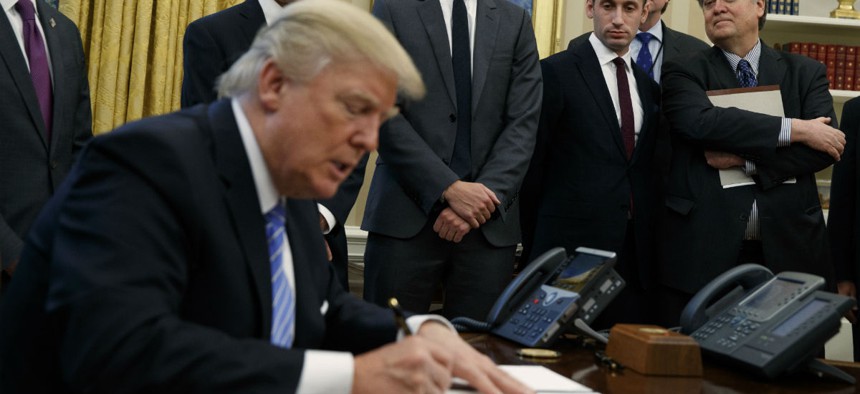Trump Signs Order to Freeze Federal Hiring
President does not elaborate on policy, other than to say military would be exempt.
President Trump on Monday followed through on a campaign promise to freeze federal hiring, issuing an executive order that would prohibit the onboarding of new civilians.
Trump did not elaborate on the new policy as he signed it in the Oval Office, saying only “except for the military” to reporters gathered in the White House. As part of his “contract with the American Voter,” Trump said in October he would institute an immediate freeze with exceptions only for members of the military and public safety and public health workers.
It was not immediately clear how the administration would define those exemptions, or if they still apply. White House Press Secretary Sean Spicer said the freeze would apply "except when necessary to meet national or public security responsibilities." He added the freeze would ensure a "more effective and efficient government," explaining the administration's priorities would be "more than a question of just cutting."
"There's been a lack of respect for taxpayer money for years in this town," Spicer said. "To see money wasted in Washington on a job that is duplicative is insulting [to taxpayers]." He said the freeze would counter a "dramatic expansion" in recent years of the civilian federal workforce, though the number of non-military federal employees remains the same as it was in 1966, according to the Office of Personnel Management. Spicer explained the order will both prevent the filling of vacancies and creating new positions.
Trump followed in President Ronald Reagan’s footsteps , who signed a hiring freeze on his first day in office in 1981. President Jimmy Carter also froze federal hiring three times over his four years in office. To implement his freeze, Reagan tasked his Office of Management and Budget director with issuing guidance that provided “exemptions in those rare and unusual circumstances where exemptions are necessary for the delivery of essential services.”
In a subsequent speech on the campaign trail, Trump said the hiring freeze would apply to “non-essential” personnel, perhaps a reference to the phrasing commonly used to describe which federal employees are sent home during government shutdowns. In 2013, about 900,000 employees, or 43 percent of the federal workforce, was subject to furloughs.
Opponents of the policy have said a hiring freeze not only disrupts government operations and delays services to citizens, but it also may not even be an effective way to reduce costs. A 1982 General Accounting Office (now the Government Accountability Office) report on Reagan and Carter’s hiring freezes found the policy was not an “effective means” of controlling federal employment “regardless of how well managed.”
GAO said: “The government-wide hiring freezes had little effect on federal employment levels and it is not known whether they saved money. Because they ignored individual agencies' missions, workload and staffing requirements, these freezes disrupted agency operations and, in some cases, increased costs to the government.”
Rather than reducing the cost on labor overall, the auditors found the administration developed “alternative sources” to get work done that increased spending.
“Any potential savings produced by these freezes would be partially or completely offset by increasing overtime, contracting with private firms, or using other than full-time permanent employees,” GAO said. “Decreased debt and revenue collections also occurred as a result of hiring freezes.”
A governmentwide hiring freeze fails to take into account actual workload, GAO said, and employee reduction should instead be “targeted to where it can best be absorbed.”
Federal employee unions have blasted Trump’s plan, saying it was unnecessary, detrimental and illustrative of the president's lack of understanding of how government works.
J. David Cox, president of the American Federation of Government Employees, said Monday the order would harm functions at Social Security Administration offices, workplace safety inspections, Environmental Protection Agency oversight of polluters and Agriculture Department food inspections. AFGE also noted the number of federal civilians -- about 2.1 million -- has not grown since the mid-1960s, and that 85 percent of federal workers live outside the Washington, D.C.-area.
“President Trump’s action will disrupt government programs and services that benefit everyone and actually increase taxpayer costs by forcing agencies to hire more expensive contractors to do work that civilian government employees are already doing for far less,” Cox said. “All Americans should be outraged that President Trump is gutting federal programs and funneling their taxpayer dollars into the hands of less-regulated private companies who answer to their corporate shareholders and not the American people.”
Tony Reardon, president of the National Treasury Employees Union, called the freeze "counterproductive" and noted recent attrition at agencies throughout government has already taken a significant toll.
“Arbitrary cuts will leave agencies scrambling to serve the public," Reardon said. "A hiring freeze takes away the agencies’ ability to make strategic decisions about their workforce."
Not all reaction to the freeze was negative; Chris Edwards, an analyst with the Cato Institute, a conservative think tank, said the policy was "no big deal."
"Obviously, people leave organizations all the time, and remaining workers adjust," Edwards said. "Private companies often go through cycles of expanding and contracting their workforces." The order demonstrated important symbolism, he added, as it showed there is a "new sheriff in town." He said the freeze makes sense as a short-term proposition as the Trump administration determines what budget reforms it would like to make and agencies work through which vacancies absolutely need to be filled.
The order followed a memorandum sent to all executive branch agencies sent by Trump’s Chief of Staff Reince Preibus instructing them to temporarily halt the issuance of new regulations. Both presidents George W. Bush and Barack Obama instituted similar regulatory pauses on their first days.
This is a developing story. Check back for updates .









